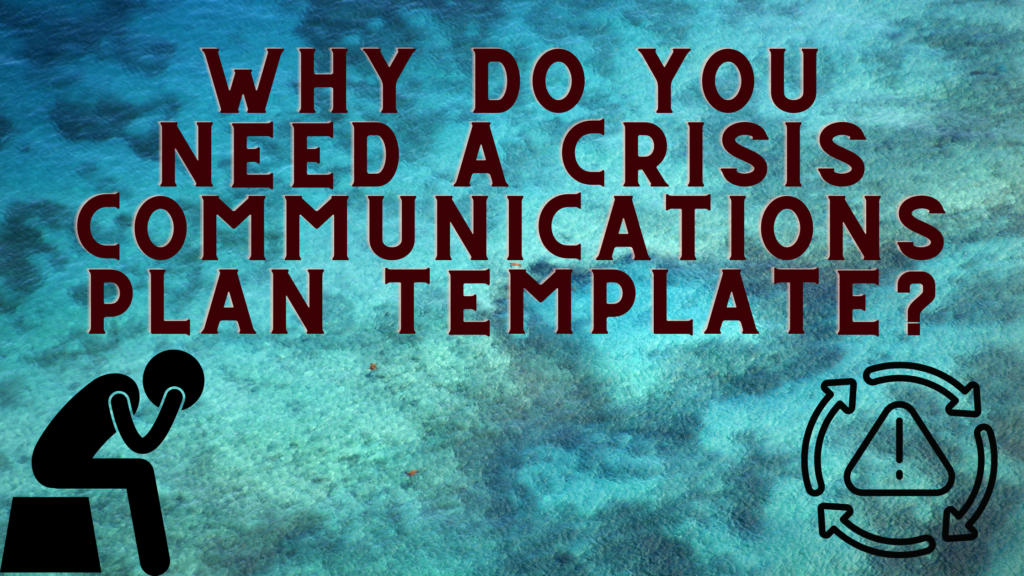
Life would be much easier on us if the emergency arrived on time. No need to prepare in advance. Unfortunately, it doesn’t. The crisis comes when you least expect it. Also, waiting until a crisis strikes before planning will probably not prevent disaster. This is why businesses need a crisis communication plan template before a crisis hits.
What is meant by Crisis Communication?
Crisis communication is the dissemination of information by an organization to deal with a crisis that affects its customers or the reputation of the organization. A company’s reputation is the idea that it will be known to everyone who knows your company, whether or not you control your reputation. Contributing to the story is therefore in the company’s best interest. Additionally, when expectations are clear, customer satisfaction increases.
Crisis communication can be very reactive, but having a crisis communication plan before you use it will simplify the process for your team members. A crisis communication plan is a set of guidelines companies use to prepare for emergencies and the unexpected. These plans include actions to be taken when a crisis occurs, communication with the public, and preventing the problem from reoccurring.
What should the plan focus on?
A crisis communication plan focuses on the organization’s response and how to communicate the crisis to stakeholders. These steps ensure that information reaches our employees, partners, customers, media, the general public, and all other valuable stakeholders. Most importantly, a crisis communication plan helps ensure the rapid release of information as well as consistent messaging across all business platforms during a crisis.
That message varies greatly depending on what the crisis entails and how it affects all parties involved.
What are some of the crisis examples?
Almost any scenario can present itself as a business crisis that requires communication from your organization. Some of the
The most common crisis types are:
- Economic – Economic loss, such as declaring bankruptcy or closing a business.
- Workforce – Personnel changes that may affect operations or reputation, such as; Holidays, layoffs, or controversial behavior by employees.
- Organization – an apology for wrongdoing or misconduct as a result of organizational practices.
- Technical – A technical failure resulting in impairment or loss of function.
- Natural – Natural disasters that require notification or changes in procedures. For example, define safety measures amid a health crisis.
Moreover, anything considered disrupting or halt business continuity is a good example of a crisis that requires communication with customers and the public. Communication plans will vary depending on the crisis you are dealing with, but here are some common strategies companies use to ensure an effective response.
Effective strategies for a Crisis Communication
- Response of the spokesperson
If your company has made a mistake, the best thing you can do is apologize and remain human. The best way to ensure that this happens is to hire a spokesperson to speak on behalf of your brand. After all, it’s much easier to build a relationship with one person than with a group of lawyers.
This person is your CEO, executive, or whoever you feel best represents your company. Choosing a good communicator is important. Because their actions influence how key stakeholders react to the situation. If they make your organization look human and you can manage your mistakes, they will play a key role in maintaining stakeholder support.
- Control damage proactively
Even if things are going well now, you should always be prepared for a crisis. Please do not worry. Don’t be a pessimist. Instead, it makes you proactive. Proactive mitigation is what you do to reduce or prevent the impact of a crisis before it even occurs. Additionally, you can train your employees to look out for suspicious or malicious emails that may arrive in their inboxes.
- Case escalations
Crises can sometimes be resolved on an individual level before reaching a viral tipping point. In these cases, it helps to set up an escalation system within your customer service team to help resolve issues before they get out of hand.
- Response to social media
Social media is a great marketing tool businesses can use to reach a global audience. But this reach works both ways, as customers can share stories, post photos, and upload videos for the world to see. A viral video that misrepresents your business can create a negative perception of your brand in millions of people. The crisis is fought both face-to-face and online. That’s why businesses need social media plans to manage their business’s digital excitement. This may include increasing staff monitoring of social channels and updating followers with new information. But no matter what, you can’t ignore social media when your business is in crisis.
- Feedback from customers
Sometimes crises happen, but they don’t make the front page of the news or make headlines on social media. Instead, you silently influence your customers and cause churn, but you don’t collect enough feedback from them so they don’t notice. Gathering feedback is a great way to prevent crises.
Because it gives you insight into what your customers think of your business. This allows critical failures to be spotted before they become crises. Customers can also share negative reviews, which can be used to improve the experience for other customers. When a customer becomes dissatisfied or escalates, the success team sees this as an opportunity to collect feedback from the customer. They start the dialogue by asking customers to review their experience and discuss any items they are unsatisfied with. This helps our team create practical procedures that we can use to meet our client’s needs.
Elements in a Crisis Communication Template
Communication plans in times of crisis can come in many shapes and sizes. They can be simple or extremely detailed and may include or exclude certain sets of information. Regardless of form or scope, any comprehensive crisis communication plan should include the following areas:
1. Determine the target: This includes defining communication goals and objectives
2. Define team and employee roles: Having a dedicated crisis response team with clearly defined roles and responsibilities is a strong foundation for effective crisis management.
3. Identify key stakeholders: Identifying and prioritizing key stakeholders allow us to better understand our key communication goals and target audience and address them accordingly.
4. Identify potential risks and crisis scenarios: The first step in this process is to evaluate the operation and identify visible weaknesses and areas of increased risk of disruption and instability.
5. Warning Mechanism: Specifically, it defines what happens when a crisis is discovered: who needs to be notified, what mechanisms are activated, and what steps are needed to get the response team up and running as quickly as possible.
6. Collect information: This area deals with internal operations from the very first announcement of an emerging crisis. For this, it is important to identify key information holders in different areas of the organization and include them in the response team or make them available for consultation.
7. The prevalence of information: Dissemination of information includes everything from emergency alert systems to media relations and internal communications.
8. Employee Guidelines (including social media): Organizations should define how they expect their members to handle work-related communications on their channels during crises and provide clear and actionable guidelines
9. Balance sheet after a crisis: The feedback team needs to properly assess the quality of the feedback, noting the practices that have yielded positive results, as well as the weaknesses in the plan
Refer to this link for a Crisis Communications Plan Template

